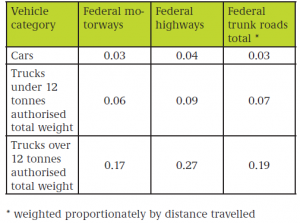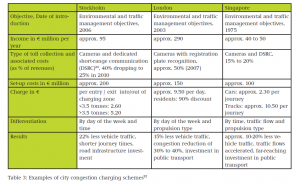Environmental and transport policy
Road pricing for cars in Germany
The coverage of the policy: Road pricing within the transport policy
Since 2005, Germany has operated the road price policy to make traffic flows more efficient and improve environment within the country based on all other EU countries’ experience. Here I would like to introduce all three different charging models for passenger cars in Germany and analysis there economic and environmental effects.
1) A time-based charge allows the unrestricted use of a particular road network for a specific period of time.
2) A distance-based or pay-as-you-go charge is a charge per kilometre on the road network covered by the toll, such as the truck toll operates in Germany.
3) An area-based charge (city centre congestion charge) collects a charge for access to or travel through city centres.
Moreover, there are also other tolls such as for tunnels and bridges. The only purpose of such toll is to maintain tunnels and bridges. Here I would like to focus on these three most important tolls
1) Time-based toll: vignette
The time-based toll, also known as the “vignette system” in reference to the toll or vignette which is displayed on the windscreen of participating vehicles, charges vehicles a time-based fee: for instance, a certain rate of price charged for the whole period such as one year. Such rate is always calculated based on the average costs for each car on a certain road network. For each driver who purchased the vignette can use the road network without limit until the end of this period. In Germany, almost all motorways can be used by this method for a period of 12 months. The advantage of the time-based toll is obvious, that the public finance does not have to pay for the road anymore, however, that the vignette can only be used to a very limited extent to fulfil the traffic management.
The vignette system is a model which only about drivers’ decisions that if or not use the road network at all in the following period, there for, the system cannot used to reduce traffic jam or location based traffic management.
The vignette system has only limited contribution to release environmental pressures. Since as we have mentioned above, that the vignette system can only effect the drivers’ decision of if to drive or not in the first place, it will not increase the cost of driving within the certain period that the driver has already paid. Therefore, unless the price of vignette is really high that there are so many drivers decide not to drive.
2) A distance-based: passenger car toll
A distance based toll is also call pay as you go toll, which is of cause calculated on the number of kilometres that a driver driven within a particular network. Such a distance based toll in applied in may EU countries such as France and Italy and it has been proven to be effective.
According to experience of all other countries, the time based toll is really effective, however, the successful experience in other states such as France may not be applicable into Germany since the motorway network in Germany is much more complicated and has more alternative road. Which means that the distance based toll can increase the burden of traffic dramatically.
The most important advantage of the distance based toll is that the environmental costs of traffic are paid for proportion and absolutely based on the usage of the motorway network. Therefore, the distance based toll policy provides the incentive to reduce the usage of traffic and environmental impact of vehicle.
However, the disadvantage of the distance based toll is also obvious, that such policy could not provide any incentive for vehicle improvement. As long as drivers pay for road network based on the distance that he/she drive, there is no incentive to improve their car to a less polluting vehicle.
3) Area based toll: congestion charge
One of the most important purposes of the road price policy is for traffic management and as a solution of traffic congestion. Therefore the most direct solution is to charge for congestion itself in city center within small are or region. Thus, the rate of charge is not related to the distance of travel or time period of traffic permission that driver purchased.
The charge of congestion is only based on the location and time of traffic the introduction of a city centre congestion charge leads to a reduction in traffic volumes during peak times.


